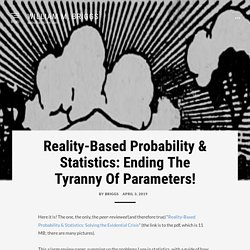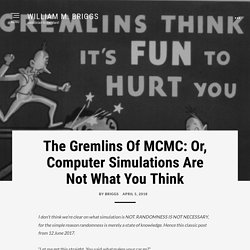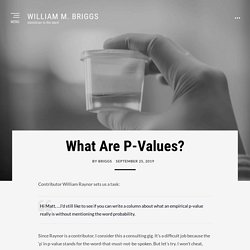

PA 2020 Voter Analysis Report. Do non citizens vote in US elections (2014) Reality-Based Probability & Statistics: Ending The Tyranny Of Parameters! – William M. Briggs. Here it is!

The one, the only, the peer-reviewed (and therefore true) “Reality-Based Probability & Statistics: Solving the Evidential Crisis” (the link is to the pdf, which is 11 MB; there are many pictures). This a large review paper, summing up the problems I see in statistics, with a guide of how escape from the void. There is no question computer scientists are kicking statisticians’ asses.
Hard. As we saw yesterday. Enough already! Section 2: NEVER USE HYPOTHESIS TESTS These are refinements to “Everything Wrong With P-values Under One Roof“, here with a mind toward cause. P-values are now officially dead. Section 3: MODEL SELECTION USING PREDICTIVE STATISTICS Do we need hypothesis tests? Regular readers will be familiar with the mechanics of predictive inference, probability leakage, and all that.
Section 4: Y CAUSE This is it! Parameter estimates are often called “effect size”, though the causes thought to generate these effects are not well specified. Scientists Use Computer to Mathematically Prove Gödel God Theorem - DER SPIEGEL. [1308.4526] Formalization, Mechanization and Automation of Gödel's Proof of God's Existence. The Gremlins Of MCMC: Or, Computer Simulations Are Not What You Think – William M. Briggs. I don’t think we’re clear on what simulation is NOT.

RANDOMNESS IS NOT NECESSARY, for the simple reason randomness is merely a state of knowledge. Hence this classic post from 12 June 2017. “Let me get this straight. You said what makes your car go?” “You heard me. “Grelims make your car go.” “Look, it’s obvious. “And if I told you instead your car runs by a purely mechanical process, the result of internal combustion causing movement through a complex but straightforward process, would that interest you at all?”
“No. That form of reasoning is used by defenders of simulations, a.k.a. Here is an abbreviated example from Uncertainty which proves it’s a mechanical process and not gremlins or randomness that accounts for the succeess of MCMC methods. First let’s use gremlin language to describe a simple MCMC example. I could also get at the answer using MCMC. N = 10000 z = rnorm(n) sum(z < -1)/n I get 0.158, which is for applications not requiring accuracy beyond the third digit peachy keen. What Are Empirical P-values? – William M. Briggs. This is part II of contributor William Raynor’s request at defining p-values without using the word probability.

This assumes you read and assimilated Part I. First, a clarification from Ryanor: A context if you want it: Product Development. I (We) have a product that works as is, but we’d like to improve it if possible (like Fisher at Rothamsted.) So the “null” is a real, working product, not some flight of academic fantasy. This is a terrific example because the causes, most but not all of them, are known in a manufacturing process. The small causes that are responsible for the small widget-to-widget variations are not as well known, or are unknown altogether. Measures will be taken on the widget. (For the record, I don’t know what Raynor’s product is or what measure(s) he tracks.) Anyway, there will be a characteristic weight due to the major causes and small departures due to the small causes. One fine day somebody says, “Why don’t we try X?” This should be easy to tell. Related. What Are P-Values? – William M. Briggs. Contributor William Raynor sets us a task: Hi Matt, …I’d still like to see if you can write a column about what an empirical p-value really is without mentioning the word probability.

Since Raynor is a contributor, I consider this a consulting gig. It’s a difficult job because the ‘p’ in p-value stands for the-word-that-must-not-be-spoken. But let’s try. I won’t cheat, either, and use euphemisms like I just did. We’re going to do this in two parts. The p-value says something about what did not happen and asks you to believe that what did happen was caused as you believe it caused if the p-value is wee. Way it works is like this. In any and all of these cases—you’ve seen a million new-research-has-shown headlines—the p-value is used to prove a cause has been found. That means if the p-value is wee, he’ll say the drug caused the improvement, that carbon dioxide caused the temperature to increase, that sex differences caused the answers on a questionnaire.